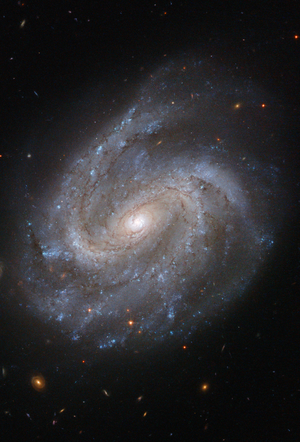NGC 201
| Galaxy NGC 201 |
|
|---|---|

|
|
| Photo from the Hubble Space Telescope | |
| AladinLite | |
| Constellation | whale |
|
Position equinox : J2000.0 , epoch : J2000.0 |
|
| Right ascension | 00 h 39 m 34.8 s |
| declination | + 00 ° 51 ′ 36 ″ |
| Appearance | |
| Morphological type | SAB (r) c |
| Brightness (visual) | 12.9 mag |
| Brightness (B-band) | 13.6 mag |
| Angular expansion | 1.8 ′ × 1.5 ′ |
| Position angle | 155 ° |
| Surface brightness | 13.8 mag / arcmin² |
| Physical data | |
| Affiliation | HCG 7 |
| Redshift | 0.014728 ± 0.000062 |
| Radial velocity | (4415 ± 19) km / s |
|
Stroke distance v rad / H 0 |
(201 ± 14) · 10 6 ly (61.7 ± 4.3) Mpc |
| history | |
| discovery | Wilhelm Herschel |
| Discovery date | December 28, 1790 |
| Catalog names | |
| NGC 201 • UGC 419 • PGC 2388 • CGCG 383-059 • MCG + 00-02-115 • IRAS 00370 + 0035 • 2MASX J00393485 + 0051355 • HCG 7C • GC 102 • H III 873 • h 43 • LDCE 0034 NED008 | |
NGC 201 is a barred spiral galaxy of the Hubble type SAB (r) c in the constellation Whale south of the celestial equator . It is estimated to be 201 million light years away from the Milky Way and has a diameter of around 105,000 ly. Together with NGC 192 , NGC 196 and NGC 197 , it forms the Hickson compact group HCG 7 .
HCG stands for Hickson Compact Group . These are collections of bright galaxies that are comparatively isolated. It is believed that the galaxies of HCG 7 will approach and eventually merge . Simulations have shown that within a billion years these galaxies will form one giant galaxy.
The object was discovered on December 28, 1790 by the German-British astronomer Friedrich Wilhelm Herschel .
Web links
Commons : NGC 201 - collection of images, videos, and audio files
